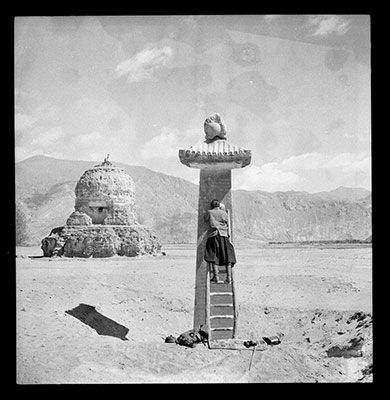
2001.59.17.60.1 (Film negative)


2001.59.17.60.1 (Film negative)

Hugh E. Richardson
Hugh Richardson
1948-50
Lhasa Area > Karcung
2001.59.17.60.1
55 x 55 mm
Negative film nitrate
Donated August 2001
The executors of the estate of Hugh E. Richardson
Hugh E. Richardson
‘High Peaks, Pure Earth’, Hugh Richardson, London, Serindia Publications, 1998 [view list of illustrations]
Manual Catalogues - Notes on negative album (outer case) - 'INSCRIPTIONS ON RDO RINGS' (in black ink on white label) and 'Inscriptions & misc.' (in black ink on yellow label) is written in Richardson's hand on the cover of the negative album. [KC 21/9/2006]
Manual Catalogues - Notes on negative index - '[ZHWAI]'
Research publication - Hugh E. Richardson, A Corpus of Early Tibetan Inscriptions, 1985 , Hertford: Stephen Austin and Son, Royal Asiatic Society, James G. Forlong Series, No. XXIX, 1985, plate 9 'The Skar-cung pillar'. [KC 29/9/2006]
Research publication - Clare Harris and Tsering Shakya (eds.) 2003 'Seeing Lhasa: British Depictions of the Tibetan Capital 1936-1947' (Serindia Publications, Chicago). Page 38. [KC 29/9/2006]
Research publication - David L. Snellgrove and Hugh Richardson, A Cultural History of Tibet , 2003, Bangkok: The Orchid Press, p.36. 'The sKar-cung stone pillar at Ra-mo-sgang near Lhasa. It has an elaborate fluted stone canopy and a shell-like finial. The base is decorated by a Chinese-inspired mountain design.' [KC 29/9/2006]
Research publication - H. E. Richardson, High Peaks, Pure Earth' , London, Serindia Publications, 1998, plate 12. "The Skar-cung pillar at Ra-ma-sgang near Lhasa." [KC 09/11/2006]
Other Information - History: Hugh Richardson discusses the history and significance of the pillar at Karcung in A Corpus of Early Tibetan Inscriptions , 1985, Royal Asiatic Society, James G. Forlong Series, No. xxxix, Royal Asiatic Society, pp. 72-81. "The pillar stands outside a small temple near the village of Ra-ma-sgang on the south bank of the Skyid-chu about two miles south-west of Lhasa. It records the renewal by Khri Lde-srong-brtsan of his father's vow to maintain the Buddhist faith ... The present-day temple is very small and neglected but it stands inside an extensive area bounded by four large ancient mchod-rten which show traces of having been covered by tiles of the colour appropriate to their position as are those at bSam-yas. A great accumulation of sand, which made it impossible to see whether there were the remains of other buildings, had covered the stone pillar ... I had enough of the sand cleared away to be able to copy the whole text; and some time later I was able also to clear the base on which the pillar stands and which was seen to be a massive block of stone carved with a pattern of mountains in the Chinese style ... Inside the courtyard of the little temple were a stone capital, similar to that on the pillar, and the remains of what appeared to be the base of another pillar which may be buried in the sand. ... " (p. 72) [KC 21/9/2006]
For Citation use:
The Tibet Album.
"Richardson's orderly copying the Karcung inscription"
05 Dec. 2006. The Pitt Rivers Museum.
<http://tibet.prm.ox.ac.uk/photo_2001.59.17.60.1.html>.
For more information about photographic usage or to order prints, please visit the The Pitt Rivers Museum.
© The Pitt Rivers Museum